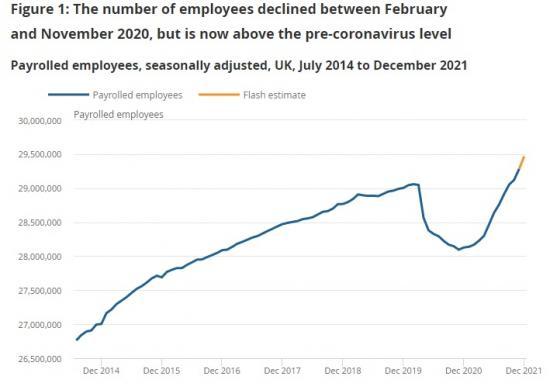Labour Market In The Regions Of The Uk: January 2022
18th January 2022

The Office for National Statistics published its latest report today.
Between November and December 2021, the number of payrolled employees in each of the regions of the UK continued to increase.
For the three months ending November 2021, the highest employment rate estimate in the UK was in the East of England (79.4%), a joint record high employment rate for the region, not seen since January to March 2019, while the lowest employment rate was in Northern Ireland (70.0%); the largest change in the employment rate compared with the same period last year was in the East of England, with an increase of 2.5 percentage points and the largest decrease in the employment rate was in Northern Ireland, at 1.1 percentage points.
For the three months ending November 2021, the highest unemployment rate estimate in the UK was in the North East (5.7%) and the lowest was in the East of England (2.7%), a record low unemployment rate and level for the region; this was also the case for Yorkshire and The Humber (3.8%), while the East Midlands also saw a record low unemployment rate for the region (3.5%).
The East Midlands saw the largest decrease in the unemployment rate compared with the same period last year, with a decrease of 2.4 percentage points, followed by the East of England and London, at 1.8 and 1.7 percentage points respectively.
For the three months ending November 2021, the highest economic inactivity rate estimate in the UK was in Northern Ireland (27.6%) and the lowest was in the East of England (18.2%); Yorkshire and The Humber and the East Midlands saw the largest changes in the economic inactivity rate compared with last year, both with an increase of 1.9 percentage points; the largest decrease in the economic inactivity rate was in the East of England, at 1.0 percentage point.
For the 12 months ending September 2021, average weekly hours worked varied between London, with 32.5 hours worked, and the North East, with 29.7 hours worked; all regions saw an increase in the average weekly hours worked compared with the same period last year, with Wales and Scotland seeing the largest increases, each with an increase of 2.2 hours.
For total weekly hours, London had the most hours worked at 152 million hours per week, while also seeing the largest increase in total hours worked compared with the same period last year, up 6.2 million hours per week; all other regions also saw increases in total hours worked compared with last year.
To read the full report go to - https://www.ons.gov.uk/employmentandlabourmarket/peopleinwork/employmentandemployeetypes/bulletins/regionallabourmarket/january2022
